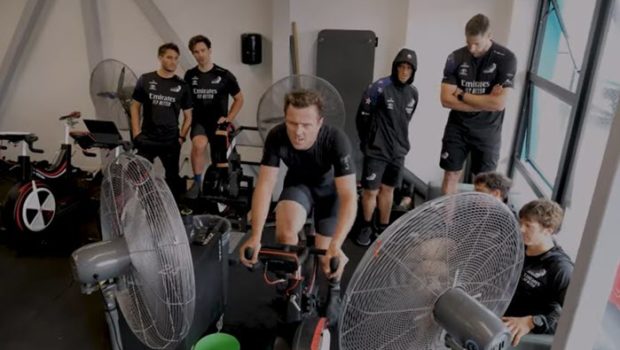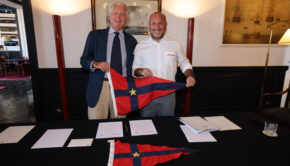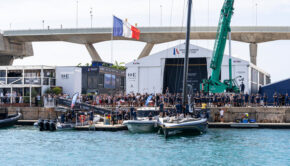Fewer sailors to sail in America’s Cup
Published on January 26th, 2023
When commenting about the costs of an America’s Cup campaign, five-time winner Russell Coutts noted in 2014 how personnel was somewhere between 50 and 60 per cent of the running costs of the teams.
There was irony in his assessment as Coutts had done more than anyone to increase the pay for sailors, but now he was on the management end, and his solution to manage costs for the 2017 America’s Cup was reducing team size by reducing boat size.
This progression began prior to the 2013 America’s Cup, as the shift from IACC yachts to the AC72 in 2013 reduced crew size from 17 to 11 sailors, and further for 2017 when six crew were needed for the AC60.
When New Zealand took over as defender, they changed the boat to the AC75 which inflated the crew size to 11 for 2021, and perhaps realizing that was expensive, initiated changes to the boat for 2024 which would need only 8 onboard.
After three events, with crew size cut in half, fewer opportunities now exist for sailors to participate in the America’s Cup. However, that number looks to get smaller yet as the AC75 require power, and with fewer people to provide it, the recruitment of strength has led teams to look beyond yachties.
How teams determine sailing roles is yet to be determined, but it does seem likely for each boat to be teaching at least two crew how to sail. Here’s an update from the Kiwi camp:
Emirates Team New Zealand have secured a substantial injection of power to their sailing team line up for their Defense of the 37th America’s Cup in Barcelona in 2024, with four new names from varied backgrounds of elite New Zealand sports.
• Dougal Allan (Multi-sport)
• Hamish Bond (rowing / cycling)
• Louis Crosby (cycling)
• Cameron Webster (rowing)
Each of the new sailing team recruits progressed through a brutal selection process overseen by Emirates Team New Zealand Trainer Kim Simperingham late in 2022 whose job was to find and physically train the elite athletes capable of outputting the immense power required to drive the systems onboard the AC75.
“We had a really interesting week of Cyclor testing for our existing sailing team as well as a list of potential new candidates, all of whom took their bodies to their absolute limits for the tests,” noted Simperingham.
“The two main physical qualities we were looking for are athletes that can sustain a really high-power output for the length of a race, up to about half an hour, and athletes that can also achieve really high peaks in power, that will be used for the maneuvers during races.”
The tests were a combination of short maximum power output tests as well as longer endurance tests.
“This gives us an idea of their physical strengths, whether it be the short sprints or the long endurance aerobic work. And then in the end, we compare that to what we’ll need on the boat and end up with a group of cyclors that will carry us through the next couple of years,” said Simperingham.
“What we found was the big guys have the power and endurance as opposed to the smaller guys with huge power to weight ratio who, although highly impressive, struggle to match the overall numbers that bigger guys can output which shows in many of the guys who have been selected.”
The original cyclor, Simon van Velthooven, who discretely joined the team in 2016 prior to the 35th America’s Cup in Bermuda when the team was developing the cyclor innovation, returns to a more familiar leg powered role along AC36 grinders Louis Sinclair, Marcus Hansen, and Marius van der Pol who were not spared the pain of the selection tests along with sailor Sam Meech who joined the team in 2022.
“It’s brutal, America’s Cups are hard so they put us through a hard test. It’s crucial to deliver the whole way through,” said van Velthooven.
Thoughts echoed by Marius van der Pol, “You sort of easily forget how much pain these little tests can put you through. So that’s a good check in and reminder.”
Emirates Team New Zealand’s Blair Tuke, who has been intricately involved in the selection process, is encouraged by the caliber of the team that has been established around him.
“We have a really potent mix of America’s Cup and AC75 experience, fresh hungry talent and raw power which I am sure will set us up strongly by the time we are on the start line for the America’s Cup Match on October 12th 2024 in Barcelona.
“To see what these guys are prepared to put themselves through in testing to qualify for the team has been really impressive and I have no doubt they will apply that same commitment to the whole team in the gym, in the shed and on the water throughout the campaign.”
Following the publication of the AC37 Protocol and AC75 Class Rule on November 17, 2021, the AC75 Class Rule and AC Technical Regulations were finalized on March 17, 2022. The entry period opened December 1, 2021 and runs until July 31, 2022, but late entries for the 37th America’s Cup may be accepted until May 31, 2023. The Defender was to announce the Match Venue on September 17, 2021 but postponed the venue reveal, confirming it would be Barcelona on March 30, 2022. The 37th America’s Cup will be held in September/October 2024.
Teams revealed to challenge defender Emirates Team New Zealand (NZL):
• INEOS Britannia (GBR)
• Alinghi Red Bull Racing (SUI)
• Luna Rossa Prada Pirelli Team (ITA)
• NYYC American Magic (USA)
• K-Challenge Racing (FRA)
Noticeboard: https://ac37noticeboard.acofficials.org/
Additional details: www.americascup.com/en/home









 We’ll keep your information safe.
We’ll keep your information safe.